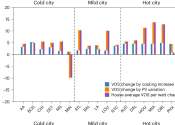Climate change will increase value of residential rooftop solar panels across US, study finds
Climate change will increase the future value of residential rooftop solar panels across the United States by up to 19% by the end of the century, according to a new University of Michigan-led study.
20 hours ago
0
6
